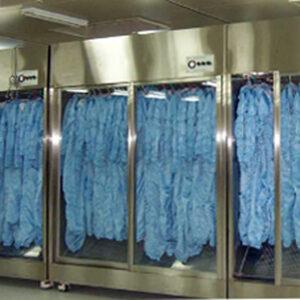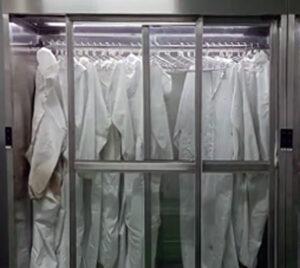What is a LAF Garment Dress Cabinet?
A LAF Garment Dress Cabinet, also known as a Laminar Air Flow Garment Dress Cabinet, is a specialized piece of equipment used in cleanroom environments to facilitate the process of donning cleanroom garments, such as gowns, coveralls, and other protective clothing. This cabinet is designed to maintain a controlled and sterile environment, ensuring that the garments worn by personnel remain uncontaminated before entering the cleanroom area.
Key features of a LAF Garment Dress Cabinet include:
Laminar Air Flow Technology:
The cabinet is equipped with a laminar air flow system that provides a continuous stream of clean and filtered air. This airflow creates a positive pressure environment within the cabinet, preventing airborne particles from entering and contaminating the garments.
Sterile Interior:
The interior of the cabinet is designed to be sterile and free from contaminants. Stainless steel construction and smooth surfaces make it easy to clean and maintain the cleanliness of the cabinet.
Gowning Protocols:
LAF Garment Dress Cabinets often include designated areas and hooks for hanging cleanroom garments. This layout ensures that personnel can follow proper gowning protocols before entering the cleanroom.
Integrated HEPA/ULPA Filters:
High-efficiency particulate air (HEPA) or ultra-low penetration air (ULPA) filters are integrated into the cabinet to remove airborne particles and maintain a high level of cleanliness.
UV-C Sterilization:
Some cabinets may feature UV-C sterilization systems that help further disinfect the garments and the cabinet’s interior.
User-Friendly Design:
LAF Garment Dress Cabinets are designed for ease of use. They often include user-friendly controls for adjusting airflow, lighting, and other settings.
Reduced Contamination Risk:
By providing a controlled environment for dressing in cleanroom attire, these cabinets minimize the risk of introducing contaminants into the cleanroom, which is crucial for industries where contamination can compromise product quality and safety.
LAF Garment Dress Cabinets are essential for industries such as pharmaceuticals, biotechnology, electronics manufacturing, and healthcare, where maintaining a clean and sterile environment is imperative. They contribute to ensuring that personnel adhere to proper gowning procedures and help maintain the integrity of the cleanroom environment.


Customized Options
Door: Tempered glass manual/automatic sliding door with SS frame, PVC curtain Floor stand / Wheels with Locking Mechanism.
A perforated panel can be set below to absorb particulates.
FAQs
Can the Cleanroom LAF Garment Dress Cabinet be tailored to meet specific cleanroom requirements?
Yes, Cleanroom LAF Garment Dress Cabinets can be seamlessly customized to align with the precise needs of cleanroom facilities. This includes adjustments to the size, capacity, and additional features that adhere to cleanroom requirements. It’s highly recommended to engage with specialized cleanroom solution providers to explore and discuss the full spectrum of customization options available.
What is the recommended replacement frequency for the HEPA filters within the Cleanroom LAF Garment Dress Cabinet?
The frequency of HEPA filter replacement hinges on multifaceted factors, encompassing the contamination levels prevalent within the cleanroom environment and the manufacturer’s specific recommendations. Adhering to the manufacturer’s guidelines and conducting periodic inspections are pivotal. This ensures optimal filter performance, subsequently replacing them when deemed necessary based on the aforementioned factors.
Can the Cleanroom LAF Garment Dress Cabinet be seamlessly integrated with other cleanroom equipment?
Absolutely, Cleanroom LAF Garment Dress Cabinets boast inherent versatility and can be effortlessly integrated with various other cleanroom equipment. These encompass pass-through chambers, air showers, gowning benches, and beyond. This integrated approach amplifies operational efficiency, thereby upholding the sanctity of the controlled cleanroom environment.
Are there specified cleaning requirements for the Cleanroom LAF Garment Dress Cabinet?
Indeed, meticulous adherence to cleaning protocols is imperative for maintaining the impeccable standards of the Cleanroom LAF Garment Dress Cabinet. Regular cleansing employing approved cleanroom disinfectants, coupled with following the manufacturer’s prescribed cleaning instructions, is paramount. Striking this balance ensures contamination prevention without compromising the cabinet’s structural integrity or the hygiene of the stored garments.
Can the Cleanroom LAF Garment Dress Cabinet accommodate a wide array of cleanroom garments?
Absolutely, the Cleanroom LAF Garment Dress Cabinets are thoughtfully designed to cater to a diverse spectrum of cleanroom garments. This encompasses gowns, gloves, masks, and attire specifically tailored for the respective industry or application. The cabinets can be adeptly customized to include dedicated compartments and storage solutions, ensuring a precise fit for the unique requirements of each garment.
What safety attributes should be sought in a Cleanroom LAF Garment Dress Cabinet?
While considering a Cleanroom LAF Garment Dress Cabinet, pivotal safety elements encompass hermetic sealed doors that thwart contaminants’ ingress, safety interlocks guaranteeing secure door closure during operation, and pertinent labeling or indicators catering to emergency scenarios. These intrinsic features collectively cultivate a secure work environment, minimizing inadvertent contamination risks.
Can the utilization of Cleanroom LAF Garment Dress Cabinet contribute to regulatory compliance?
Certainly, deploying Cleanroom LAF Garment Dress Cabinets bolsters regulatory compliance by offering a structured storage solution for cleanroom apparel. Complying with industry-specific regulations and standards is integral in safeguarding the safety and quality of products manufactured within cleanroom environments.
Is it feasible to relocate the Cleanroom LAF Garment Dress Cabinet if necessary?
Depending on design and construction, the feasibility of relocating Cleanroom LAF Garment Dress Cabinets is often attainable. However, it’s prudent to seek guidance from the manufacturer or reputable service providers. They can facilitate the proper disassembly, relocation, and reinstallation processes to ensure the cabinet’s structural integrity and continued optimal performance.
Are there specific certifications or standards applicable to Cleanroom LAF Garment Dress Cabinets?
Cleanroom LAF Garment Dress Cabinets may adhere to various industry-specific certifications and standards. These may encompass ISO 14644 for cleanroom classifications, UL (Underwriters Laboratories) certification for electrical safety, or CE (Conformité Européene) marking aligning with European standards. Prior to acquisition, it’s advisable to ascertain the specific certifications and standards upheld by the cabinet.
Can the Cleanroom LAF Garment Dress Cabinet be utilized across cleanrooms with varying cleanliness classes?
Indeed, the versatility of Cleanroom LAF Garment Dress Cabinets extends to cleanrooms featuring diverse cleanliness classes. To ensure optimal alignment, these cabinets can be meticulously tailored to fulfill the specific requirements of each cleanliness class. This tailored approach sustains the designated level of contamination control, fostering an environment conducive to quality outcomes.
Can the Cleanroom LAF Garment Dress Cabinet accommodate garments with specialized prerequisites, such as ESD (Electrostatic Discharge) protection?
Absolutely, Cleanroom LAF Garment Dress Cabinets can be ingeniously designed to cater to garments with specialized needs, including those necessitating ESD protection. By ingeniously incorporating appropriate materials and features offering conductive or dissipative properties, these cabinets can proficiently house ESD-sensitive garments. This proactive approach curbs the risk of electrostatic discharge and potential harm to sensitive electronic components.
Related Contents:
- Navigating Biosafety Cabinet Classes: A Complete Overview
- Bag-In/Bag-Out (BIBO) Systems: Operation and Maintenance Guide
- The Ultimate Guide to YOUTH LAF Garment Dress Cabinets: Ensuring Sterility in Cleanroom Environments
- Comprehensive Guide to Biosafety Cabinets: Safeguarding Research and Laboratories
- The Ultimate Guide to YOUTH LAF Garment Dress Cabinets: Ensuring Sterility in Cleanroom Environments
- Mastering Clean Room Technology with Fan Filter Units (FFUs)
- Comprehensive Guide on Biological Safety Cabinets: Ensuring Laboratory Safety and Integrity
- The Ultimate Guide to YOUTH LAF Garment Dress Cabinets: Ensuring Sterility in Cleanroom Environments
- Essential Cleanroom Gowning Protocols and Contamination Prevention Strategies

























